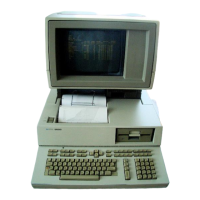3-6
Testing
and
Troubleshooting
The CPU chip contains a revision identifier accessible by the operating system. The revision
identifier
is
the microcode release date. The format
is
VYYYMMDD
where
YYVY
is
the year,
MM
is
the month,
and
DO
is
the day.
lOP Finstrate
Each
lOP
in
the stack initiates
its
self-test. Internal hardware registers are tested for read/write
ability,
and
the MPB interface
is
tested for the ability to communicate
on
the MPB. Successful
c<?91pletion
of the self-test indicates a greater than
95%
confidence
in
the lOP chip,
board
integrity,
and
MPB/IOP connection. The self-test does not test the printed circuit lOP buffer card which plugs
into the
lOP finstrate. This card
is
tested
on
powerup by the self-test supervisory code resident
in
the operating system.
The
lOP chip contains a revision identifier accessible by the operating system. The revision identi-
fier
is
the microcode release date. The format
is
YYVYMMDD
where
YYVY
is
the year,
MM
is
the
month,
and
DO
is
the day.
RAM
Boards
Each memory controller
first
performs a self-test
and
then a memory test
in
parallel with other
memory controllers. The self-test checks
all
of the memory controller circuits, data paths,
and
operations except the sending of messages
on
the MPB which
is
deferred until after the memory
test. The memory controller purposely introduces a double-bit failure so the
CPU can test the error
detection
and
notification process.
The memory test consists of pattern-testing the memory to distinguish between non-existent mem-
ory, good
RAM,
and
RAM
with hard failures. If a faulty location
is
detected, a flag
is
set to indicate
that the 16K-byte memory block
in
which the failure was detected
is
suspect. The self-test supervis-
ory code tests these blocks later to determine
if
the failure
is
correctable
or
if
the block should
remain
"mapped
out".
The
RAM
boards provide 256K, 512K, or 1 Megabyte of
RAM
per board. The boards contain
memory chips
and
a memory controller chip
(MC).
Double bit error detection
and
single bit
correction require part of the memory chip capacity. There are enough memory chips
on
the board,
so that 256K, 512K,
or
1 Megabyte of memory
is
still
available after the double bit
and
single bit
requirements are met.
The
MC
interfaces the memory processor bus
and
memory. It also does error detection
and
correction, memory mapping,
and
memory healing.
At
powerup the
MC
does a self-test. The
self-test supervisory code then tests
RAM
memory by executing writes
and
reads to each location.
The
MC
does a Hamming code check. If
an
error occurs, the associated 16K-byte block of memory
is
mapped
out.
If a single-bit error
is
detected during run time, the
MC
corrects the bit
and
sends the corrected
word. The
MC
then performs the memory healing process by copying the corrected word into
one
of
32
healing locations within the
MC.
The corrected word
is
copied into a healing location.
On
subsequent accesses to the location which had produced the error, the
MC
reads the healer
location instead. There
is
no
degradation
in
memory access time.

